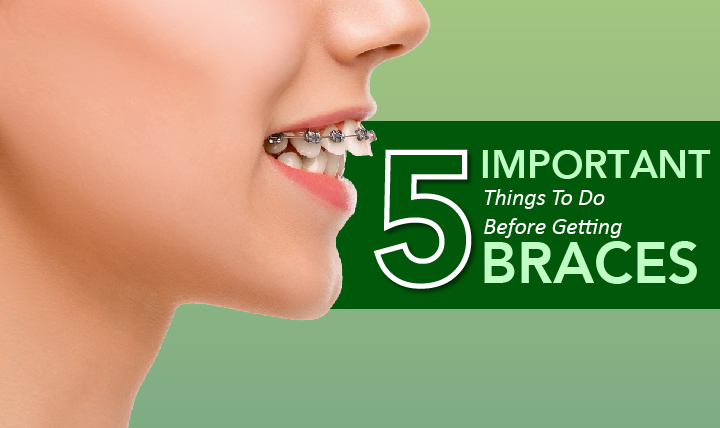5 Important Things to Do before Getting Braces
Crooked teeth can be problematic irrespective of age or the condition of the mouth. It significantly impacts a person’s self-esteem since misaligned and unusually placed teeth do not look pleasant and impact their overall personality. Even a patient with good oral hygiene but with crooked teeth may invite negative judgments from people.
Therefore, in dentistry, children are closely monitored when they start developing adult teeth. The growth and formation of the permanent teeth can be tracked as soon as they begin to emerge to ensure their complete health. If these teeth are crooked, childhood is the best time to take the necessary corrective measures.

In the case of children developing adult teeth, the mouth is still growing, and the tissues are more malleable and flexible than those in the case of adults. Therefore, the crooked teeth in a child can be more easily fixed before the onset of adolescence, since this is a time when appearance means everything. While crooked, imperfect, stained, misaligned teeth can give rise to social and emotional challenges.
For aligning teeth and managing the appearance of crooked teeth, there are many orthodontic treatments available today that include dental braces, aligners, invisible/clear braces, among others. Modern dental braces are a lot more comfortable and a lot less noticeable than the older alternative orthodontic treatments. However, below are the five things one should do before getting dental braces, which will help to prepare the patient and to ensure they get the best result for their oral health as well as their smile.
1. Gearing up for braces
Before getting dental braces, it is better to book an appointment with the dentist to get a routine check-up and cleaning. The dentist requires the teeth and gums to be healthy and clean before fitting the braces. Moreover, it is essential to thoroughly brush and floss the teeth leading up to the appointment with the dentist to make sure that the gums and teeth are in the best possible condition on the day of application of braces, or for that matter, any orthodontic treatment.
2. Eating the right foods
Several foods may not be suitable for dental braces. Some foods can pop brackets and bend wires resulting in unexpected trips to the dentist’s office. In the week before the appointment, it is better to indulge in a few of the treats that one may need to entirely avoid during treatment. These foods include nuts, hard lollies, chewy toffees, popcorn, hard crust pizzas or bread, and crunchy fruits (like apples) and vegetables (like raw carrots), among others.
3. Taking a ‘Before’ selfie/picture
Self-consciousness about one’s appearance, or teeth, in particular, makes them lose confidence. These people often tend to smile with their mouths closed. However, before getting dental braces, one can click a photo with their mouth wide open and teeth on display. Looking back on those misaligned teeth before treatment and seeing the drastic change in smile afterward will be a pleasant experience.
4. Running the tongue over the teeth
One should ensure not to poke around the braces with the tongue. Before the appointment for dental braces, it is better to clean the teeth and run the tongue over them thoroughly. This is because the smoothness of the teeth can be experienced only after the braces come off.
5. Getting cavities filled in
Dental braces can be fitted without getting the cavities filled in. However, it is always better to tend to the cavities first. This can help with easing any pain, discomfort, swelling, or dangers that may result due to unattended cavities. The dentist may suggest the further course of treatment for cavities before proceeding with the braces.
In dentistry, the first appointment does not consist of fitting in dental braces as the first step of the orthodontic treatment. A few measures are required to be taken care of beforehand, such as orthodontic x-rays and examinations. During the first meeting, the dentist will assess the exact tooth movements for straightening the teeth and aligning the jaw. After the initial consultation, the appropriate treatment plan will be created to fit in the braces.
After the braces are inserted, one should take all the necessary measures to avoid discomfort. Taking the pain relief medication, eating soft foods, and brushing the teeth after eating can ensure the necessary care required to be taken after fitting in the braces.
